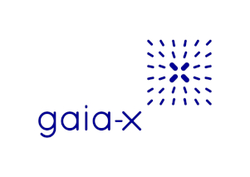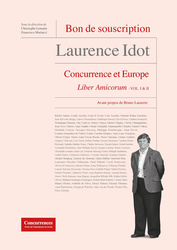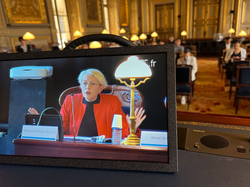The recent news
July 8, 2022
Publications

► Full Reference: Tardieu, H., Frison-Roche, M.A., Gouriet, M., Gronlier, P., Compliance, and resulting consequences on the labelling framework of Gaia-X, July 2022.
____
________
July 6, 2022
Publications

🌐follow Marie-Anne Frison-Roche sur LinkedIn
🌐subscribe to the Newsletter MAFR Regulation, Compliance, Law
____
► Full Reference: M.-A. Frison-Roche, "L'appui du Droit de la Compliance pour la maîtrise quotidienne du Droit de la concurrence" ("The support of Compliance Law for the daily mastery of Competition Law"), in C. Lemaire & F. Martucci (eds.), Liber Amicorum Laurence Idot. Concurrence et Europe, vol. I, pref. C. Lemaire & F. Martucci, foreword B. Lasserre, Concurrences, 2022, pp. 369-374
____
► English Summary of the article: Competition Law has become so huge and has included so many regulations and "regulatory" perspective that we end up giving up trying to grasp it as a whole, preferring to become a specialist in one of its parts. That would be to lose sight of the simple and strong reason that unites the whole and gives it its breath: Freedom.
Freedom experienced by the persons in their daily economic action, Freedom guarded by Competition Law, always returning to its principle: Free Competition. Therefore, the European Union places great emphasis on Competition. To make effective and to keep it in this state, “Competition Policy” is based on Competition Law, but if authorities and judges do not blame companies for their power, they do not rely on it.
To do this, Competition Law must be supported by Compliance Law, which strongly encourages companies to act for the effectiveness and the promotion of competitive principles. Competition Law is thus slipping from the Ex-Post towards the Ex-Ante, the commitments of companies leading them to cease being passive, even punished, to become convinced actors and themselves pedagogues. Something to please a great Professor of Competition Law, to whom homage is paid here.
____
📗read the Table of Contents of the book in which this article is published (in French)
____
🚧read the bilingual Working Paper which is the basis of this article, with additional developments, technical references and hyperlinks
____
📝read the article (in French)
________
July 5, 2022
Interviews

► Référence complète : Frison-Roche, M.-A., entretien avec Olivia Dufour, « La Cour suprême a déclenché la bombe de la sécession. Que faire ? », 5 juillet 2022.
____
____
💬 Entretien mené à propos du sens, de la valeur et de la portée système de l'arrêt Dobbs v. Jackson rendu par la Cour suprême des Etats-Unis le 24 juin 2022.
► Présentation de l'interview par Olivia Dufour : Alors que l'arrêt Dobbs v. Jackson du 24 juin 2022 de la Cour suprême des Etats-Unis sur l'avortement n'en finit pas de susciter l'émotion, déjà d'autres droits fondamentaux menacent de perdre leur qualité de droit constitutionnel fédéral. A commencer par le mariage homosexuel. Mais ce n'est pas la seule conséquence de cette nouvelle jurisprudence ultra-conservatrice. Pour le professeur Marie-Anne Frison-Roche, ce qui s'apparente à un "suicide institutionnel" de la part de la Cour a déclenché un mouvement de sécession. En d'autres termes, les Etats-Unis sont en passe de se désunir. Pour autant, rien n'est perdu. Explications.
Les questions posées étaient les suivantes :
Actu-Juridique : L'arrêt de la Cour suprême américaine sur l'avortement a beaucoup ému en France. En réalité, cela ne semble être que le début d'un mouvement de fond. Qu'en est-il ❓ ?
🔑Réponse MaFR
Actu-Juridique : Qu'est-ce que cette conception originaliste qui semble désormais être celle de la Cour suprême 'arrêt de la Cour suprême américaine sur l'avortement a beaucoup ému en France. En réalité, cela ne semble être que le début d'un mouvement de fond. Qu'en est-il ❓
🔑Réponse MaFR
Actu-Juridique : On comprend donc que l'avortement n'ayant pas été envisagé au XIX siècle, il ne peut pas être protégé par la Constitution au XXIème siècle❓
🔑Réponse MaFR
Actu-Juridique : Cela engendre donc un séisme dépassant de loin les seules conséquence d'un revirement de jurisprudence ❓
🔑Réponse MaFR
Actu-Juridique : C'est donc en vertu de cette logique que le port d'arme est qualifié, contrairement au droit à l'avortement, de droit constitutionnel à valeur fédérale ❓
🔑Réponse MaFR
Actu-Juridique : Est-ce également cette nouvelle logique qui a présidé à l'arrêt du 30 juin 2022 sur la lutte contre les gaz à effet de serre ❓
🔑Réponse MaFR
Actu-Juridique : En quoi l'arrêt sur l'avortement peut-il bouleverser les Etats-Unis ❓
🔑Réponse MaFR
Actu-Juridique : Actuellement, l'opinion semble à la fois sidérée et impuissante, faut-il se résoudre à voir prospérer cette nouvelle jurisprudence ❓
🔑Réponse MaFR
Actu-Juridique : En France, cet arrêt a suscité la crainte que l'avortement ne soit remis en cause ici aussi et certains réclament l'inscription du droit à l'IVG dans la Constitution. Est-ce une bonne idée ❓
🔑Réponse MaFR
Actu-Juridique : Mais alors que faire pour protéger le droit à l'IVG en France ❓
🔑Réponse MaFR
Actu-Juridique : Revenons aux Etats-Unis, comment empêcher que la Cour suprême ne revienne sur le caractère fédéral de nombreux droits ? Le Congrès pourrait-il intervenir ❓
🔑Réponse MaFR
Actu-Juridique :Une telle situation pourrait-elle se produire en Europe ❓
🔑Réponse MaFR
_____
July 1, 2022
Conferences

♾️follow Marie-Anne Frison-Roche on LinkedIn
♾️subscribe to the Newsletter MAFR Regulation, Compliance, Law
____
► Full Reference: M.-A. Frison-Roche, "Compliance, Artificial Intelligence and Business Management: the right measure" ("Compliance, Intelligence artificielle et gestion des entreprises : la juste mesure"), participation to the Conference coordinated by Mustapha Mekki, L'intelligence artificielle et la gestion des entreprises. July 1st, 2022.
____
🎥 see the conference (in French)
____
consult the slides having been used as brief notes for deliver the lecture (inf French)
____
🚧read the bilingual Working Paper having been used as basis for this conference
____
📝This work will be the basis for an article.
____
► Summary of the Lecture: Of the next European Regulation on artificial intelligence, the European Commission has a quite neutral conception of AI for obtaining a consensus between the Member States, while the Regulators and certain States have a more substantial conception of technology, wanting its power to be used to protect people, firstly from these new tools themselves, secondly from what is an amplification of the evils of the classic world, such as hate or misinformation. This is the reflection of two conceptions of Compliance.
Firstly, Compliance can be defined as neutral processes that increase the effectiveness of what would be the obligation for companies or their desire for efficient risk management (in particular the consideration of "legal risks") to prove being "conform" to all regulations that are applicable to itself and all persons to whom the firm is accountable. This is often referred to as the "compliance obligation" or "obligation of conformity".
This conception implies considerable practical consequences for the company which, in order to succeed in this "total exploit", would then have to resort to artificial intelligence tools constituting a "total and infallible solution", which mechanically generate for it the obligation to "know " all the "regulatory mass", to detect all "non-compliances", to conceive its relationship to the Law in terms of "risk of non-compliance", fully supported by Compliance by Design which could, without human intervention , eliminate legal risk and ensure "compliance total efficiency" in Ex Ante.
The "legal price" of this technological dream is extremely high because all the "regulatory" requirements will then be transformed into obligations of result, any failure generating liability. The Compliance probationary system will become overwhelming for the company, both in terms of burden of proof, means of proof, and transfers, without exemption from proof. Objective responsibilities for others will multiply. The "law of conformity" will multiply Ex Ante systemic penalties, the border with criminal law being less and less preserved.
It is essential to avoid this, both for businesses and for the Rule of Law. For this, we must use Artificial Intelligence to its proper extent: it may constitute a "massive aid", without ever claiming to be a total and infallible solution, because it is the human who must be at the center of the compliance system functioning thank to the firms and not the machinery.
For this, it is necessary to adopt a substantial conception of Compliance Law (and not a sort of Conformity Law or Obedience Law). It does not at all cover all the applicable regulations and it is not at all "neutral", being in no way a series of processes. This new branch of Law is substantially built on Monumental Goals. These are either of a negative nature (preventing a systemic crisis from happening, in many but specific perspectives: banking, financial, health, climate, etc.), or of a positive nature (building a better balance, in particular between human beings, in the company and beyond).
In this conception which appears more and more strongly, artificial intelligence finds its place, more modest. As Compliance Law is based on information, Artificial Intelligence is essential to capture it and make first connections, first stages for successive analyses, done by human beings, making what is essential: the commitment of the company, both by the leaders and by all those who are "embarked" by a "culture of Compliance" which is at both built and common.
This restores the required seal between Criminal Law and what can be asked of the mechanical use of Artificial Intelligence; this puts the obligation of means back as a principle. This restores the principal place to the lawyer and the compliance officer, so that the culture of compliance is articulated with the specificities of a sector and the identity of the company itself. Indeed, the culture of compliance being inseparable from a culture of values, Compliance by design requires a dual technique, both mathematical and legal culture. It is why European Compliance Law, because it is rooted in the European humanist tradition, is a model.
________
For further:
📘Frison-Roche, M.-A. (ed.), Compliance Monumental Goals, 2022
📘Frison-Roche, M.-A. (ed.), Compliance Jurisdictionalisation, 2022
📘Frison-Roche, M.-A. (ed.), Compliance Tools, 2021
📓Frison-Roche, M.-A., L'apport du Droit de la Compliance à la Gouvernance d'Internet, 2019
📕Frison-Roche, M.-A. (ed.), Pour une Europe de la Compliance, 2019
📕Frison-Roche, M.-A. (ed.), Régulation, Supervision, Compliance, 2017
📕 Frison-Roche, M.-A. (ed.), Internet, espace d'interrégulation, 2016
📝 Frison-Roche, M.-A., Compliance Monumental Goals, beating heart of Compliance law, 2022,
📝 Frison-Roche, M.-A., Role and Place of Companies in the Creation and Effectiveness of Compliance Law in Crisis, 2022
📝 Frison-Roche, M.-A., Assessment of Whistleblowing, and the duty of Vigilance, 2022
📝Frison-Roche, M.-A., Drawing up Risk Maps as an obligation and the paradox of he "compliance risks", 2021
__________
June 29, 2022
Interviews

► Référence complète : Frison-Roche, M.-A., Droit à l’avortement : « Le processus de sécession est dans la décision » , Entretien avec Laurence Neuer, Le Point, 29 juin 2022.
____
________
June 29, 2022
Compliance: at the moment

► Référence complète : Frison-Roche, M.-A., Seuls les droits subjectifs techniques ne sont pas touchés par l'arrêt Dobbs: c'est sur eux qu'il faut construire une nouvelle théorie de l'entreprise, 29 juin 2022.
___
► Introduction de l'article : Tout d'abord il y a deux types de réaction possible face à un événement critiquable. Elles peuvent se cumuler mais chacune prend de l'énergie. Soit critiquer l'événement condamnable (puisqu'il est critiquable, renforçant ainsi la mauvaise opinion que l'on a de lui) ; soit en limiter la portée (puisqu'il est critiquable, autant faire en sorte qu'il ait le moins d'effet possible).
Que l'arrêt Dobbs v/ Jackson rendu le 24 juin 2022 par la Cour suprême des Etats-Unis soit critiquable, tout le monde en est à peu près d'accord. Des centaines de commentaires vont dans ce sens ; des milliers de réactions vont dans ce sens. L'on peut continuer à le critiquer. Cela renforce l'opinion que l'on a déjà. Cela prend de l'énergie.
Peut-être vaut-il mieux utiliser son énergie à limiter la portée de cet arrêt. Mettre son énergie dans cet effort-là. Or cet effort en requiert beaucoup. Donc puisqu'il est acquis que cet arrêt est critiquable, concentrons-nous sur les moyens pratiques d'en limiter la portée.
L'on songe à modifier le Droit français en inscrivant le droit à l'avortement dans la Constitution (I). Mais si l'on revient aux Etats-Unis, car l'arrêt de la Cour suprême n'a pas de portée sur le Droit constitutionnel français, il faut mesurer que tous les droits subjectifs "politiques" non-ancrés dans "l'histoire américaine" sont touchés par l'arrêt du 24 juin 2022, la portée de l'arrêt allant bien au-delà du droit à l'avortement (II). La Cour est donc délivrée de la totalité de sa propre jurisprudence, ce que ne sont pas les cours constitutionnelles européennes, et c'est en cela que l'arrêt est catastrophique car non seulement il touche tous les droits subjectifs "politiques", mais il efface toute la jurisprudence de la Cour concernant les droits subjectifs "politiques" que l'on pourrait dire "nouveaux" (III). Plus encore, trois jours après, la Cour suprême a rendu un arrêt concernant un droit politique ancré dans l'histoire américaine, le droit à la liberté d'expression, qu'elle a interprété très largement, pour bloquer le licenciement d'un enseignant sportif d'une école publique qui faisait des prières sur le terrain de sport, procédant ainsi à un revirement de jurisprudence. La Cour ne serait donc pas non plus liée par sa jurisprudence sur les droits subjectifs politiques ancrés historiquement, pouvant les interpréter d'une façon conservatrice, sans "conserver" l'interprétation "progressiste" que la Cour en avait faite (IV). La solution serait donc de travailler sur ce qui reste : les droits subjectifs non-politiques : or, ce sont des droits auxquels les juristes conservateurs, qui dominent la Cour, sont attachés parce qu'ils sont liés à la liberté contractuelle et à la liberté d'entreprendre. Ils seront en mauvaise position pour les restreindre. Cela désigne ceux qui vont devoir, et pouvoir, défendre les femmes, et plus généralement les êtres humains, aux Etats-Unis : les entreprises (V).
____
Lire les développements de l'article ⤵️

June 21, 2022
Publications

♾️ follow Marie-Anne Frison-Roche on LinkedIn
♾️subscribe to the Newsletter MAFR Regulation, Compliance, Law
____
► Full Reference: Frison-Roche, M.-A. Compliance, Artificial Intelligence and Business Management: the right measure, Working Paper, June 2022.
____
► Summary of the Working Paper: Of the next European Regulation on artificial intelligence, the European Commission has a quite neutral conception of AI for obtaining a consensus between the Member States, while the Regulators and certain States have a more substantial conception of technology, wanting its power to be used to protect people, firstly from these new tools themselves, secondly from what is an amplification of the evils of the classic world, such as hate or misinformation. This is the reflection of two conceptions of Compliance.
Firstly, Compliance can be defined as neutral processes that increase the effectiveness of what would be the obligation for companies or their desire for efficient risk management (in particular the consideration of "legal risks") to prove being "conform" to all regulations that are applicable to itself and all persons to whom the firm is accountable. This is often referred to as the "compliance obligation" or "obligation of conformity".
This conception implies considerable practical consequences for the company which, in order to succeed in this "total exploit", would then have to resort to artificial intelligence tools constituting a "total and infallible solution", which mechanically generate for it the obligation to "know " all the "regulatory mass", to detect all "non-compliances", to conceive its relationship to the Law in terms of "risk of non-compliance", fully supported by Compliance by Design which could, without human intervention , eliminate legal risk and ensure "compliance total efficiency" in Ex Ante.
The "legal price" of this technological dream is extremely high because all the "regulatory" requirements will then be transformed into obligations of result, any failure generating liability. The Compliance probationary system will become overwhelming for the company, both in terms of burden of proof, means of proof, and transfers, without exemption from proof. Objective responsibilities for others will multiply. The "law of conformity" will multiply Ex Ante systemic penalties, the border with criminal law being less and less preserved.
It is essential to avoid this, both for businesses and for the Rule of Law. For this, we must use Artificial Intelligence to its proper extent: it may constitute a "massive aid", without ever claiming to be a total and infallible solution, because it is the human who must be at the center of the compliance system functioning thank to the firms and not the machinery.
For this, it is necessary to adopt a substantial conception of Compliance Law (and not a sort of Conformity Law or Obedience Law). It does not at all cover all the applicable regulations and it is not at all "neutral", being in no way a series of processes. This new branch of Law is substantially built on Monumental Goals. These are either of a negative nature (preventing a systemic crisis from happening, in many but specific perspectives: banking, financial, health, climate, etc.), or of a positive nature (building a better balance, in particular between human beings, in the company and beyond).
In this conception which appears increasingly strongly, artificial intelligence finds its place, more modest. As Compliance Law is based on information, Artificial Intelligence is essential to capture it and make first connections, first stages for successive analyses, done by human beings, making what is essential: the commitment of the company, both by the leaders and by all those who are "embarked" by a "culture of Compliance" which is at both built and common.
This restores the required seal between Criminal Law and what can be asked of the mechanical use of Artificial Intelligence; this puts the obligation of means back as a principle. This restores the principal place to the lawyer and the compliance officer, so that the culture of compliance is articulated with the specificities of a sector and the identity of the company itself. Indeed, the culture of compliance being inseparable from a culture of values, Compliance by design requires a dual technique, both mathematical and legal culture. It is why European Compliance Law, because it is rooted in the European humanist tradition, is a model.
________
June 21, 2022
Interviews

Référence complète : Frison-Roche, M.-A., L'efficacité de la compliance illustrée par l'affaire Youporn, entretien avec Olivia Dufour, 21 juin 2022.
____
____